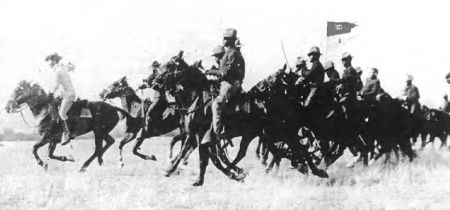The 10th Cavalry was one of the original six regiments of the regular army set aside for black enlisted men. These were authorized by Congress in the act of July 28, 1866 reorganizing the army for post-Civil War service, mainly against native peoples in the West. Colonel Benjamin Grierson, a music teacher with no pre-Civil War military experience, was the 10th’s first commander. Grierson distinguished himself by leading a daring cavalry raid into Mississippi during General Grant’s Vicksburg campaign of 1863. The regiment was organized at Fort Leavenworth and later Fort Riley, Kansas, with the last company assembled and in the field by October 1867. It served under Grierson for more than twenty years, until his promotion to be brigadier general in November 1888.
The 10th served against the Cheyenne in Kansas at the end of the 1860s, then against the Kiowa and Comanche in Indian Territory, and in the Apache campaigns of the early 1880s. It was involved in the pursuit of Geronimo in 1886, but did not take part in his capture. Its only Medal of Honor recipient in the West, Sergeant William McBryar, received his award for 1890 operations against Apaches who resisted confinement to a reservation. Nine of the 10th’s seventeen fatalities came against the Apache.
Lieutenant Henry Flipper, the first black graduate of the U.S. Military Academy (1877), served with the 10th until 1882. Flipper was discharged after a court-martial conviction for conduct unbecoming an officer. He received a posthumous pardon from President William Clinton in 1999.
During the Cuban campaign in 1898, the 10th participated in operations at Las Guasimas on June 24 and on San Juan Hill on July 1. Sergeant Major Edward L. Baker received the Medal of Honor for rescuing a wounded comrade under fire at the base of Jan Juan Hill. Four others—Corporal William Thompkins, and Privates Dennis Bell, Fitz Lee, and George Wanton—received the medal for bravery in an amphibious operation that sought to land insurgents at Tayabacao on the south shore of Cuba. Seven soldiers of the 10th were killed in that campaign.
From the turn of the century to World War I, the regiment served in China (Boxer Rebellion); Nebraska and Wyoming (1902-1907); the Philippines (1907-1909); and Fort Ethan Allen, near Burlington, Vermont (1909-1913). The latter assignment included a practice march in the summer of 1913 from Vermont to the Shenandoah Valley of Virginia. The regiment served on the Mexican border from 1916 to 1922. While participating in General John Pershing’s punitive expedition against Mexican Revolutionary Francisco “Pancho” Villa, it lost nine killed (two officers and seven enlisted men) in a firefight with Mexican forces at Carrizal on June 21, 1916. It was still a horse cavalry regiment when it was assigned to be part of the 2nd Cavalry Division in October 1940. The 10th saw no action in World War II and was deactivated in North Africa in May 1944 with its personnel transferred to other service units.

